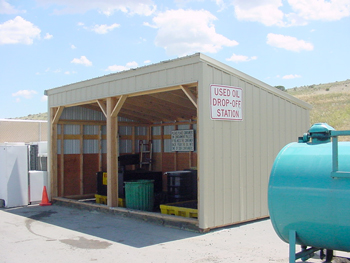 |
|
Please note: This summary is provided to help you understand the regulations. Consult the references provided for links to the full text of the regulations.
This section covers federal and state regulations regarding used oil. In addition to the vehicle crankcase oil that is traditionally referred to as "used oil," the term "used oil" includes nearly any of the petroleum based or synthetic substances that are used for lubrication, heat transfer, or hydraulic fluid, including brake, transmission and power steering fluids. In some states it is referred to as "waste oil."
Who is covered by the regulations? There are some exceptions, but most transportation facilities that generate used oil as a result of vehicle or machine maintenance are regulated as used oil generators and must comply with the applicable federal and state regulations. The used oil rules apply to nearly any of the petroleum based or synthetic substances that are used for lubrication, heat transfer, or hydraulic fluid. If you have any questions on what is and what is not considered used oil, check out EPA's Used Oil Guidance Table. What is the purpose of the regulations? Used oil is regulated because it contains harmful contaminants, such as benzene and lead, picked up during the operation of a vehicle or machine. The regulations require safe management and disposal of used oil, which protects not just drinking water, fish, and land, but also the workers in your shop. Also, federal and state used oil regulations encourage oil recycling, which conserves a valuable non-renewable resource. EPA treats used oil differently from most other wastes because it can readily be recycled or burned for energy recovery. In fact, under the Federal Standards for Management of Used Oil (40 CFR 279), EPA presumes that used oil is to be recycled. As such, EPA has streamlined the rules to make it easier and less expensive for businesses to manage this material. However, if used oil is going to be disposed of, then it is not regulated under these "management standards." Instead, it is regulated like other potentially hazardous wastes (e.g., the generator must make a hazardous waste determination). For more information on hazardous waste rules, see the TERC Hazardous Waste section. Also, it is important to note that if used oil is mixed with a listed hazardous waste (e.g., spent solvent) or if it contains more than 1,000 parts per million (ppm) of total halogens, then it is a hazardous waste and must be managed as such. The 1,000 ppm total halogens rule does not apply to metalworking fluids containing chlorinated paraffins, if the fluids are recycled. The standards apply to all used oil handlers, regardless of the amount of the oil they handle. The following requirements relate mainly to storage and to cleaning up leaks and spills:
Used oil must be transported by a transporter with an EPA ID number, unless:
If you plan to burn used oil as a fuel, there are a couple of rules to follow:
Before burning used oil, check with your state or local air quality division to inquire about air quality requirements, and check with state building code personnel to inquire about building codes for the installation and use of the burner. If you store more than 1,320 gallons of used oil, in addition to the above used oil management standards, your oil storage area is regulated under the Spill Prevention, Control and Countermeasure (SPCC) rule (see SPCC requirements), To meet these requirements, generators typically need a secondary containment system to prevent used oil from contaminating the environment. Most states have adopted the federal management standards for used oil. However, some states use slightly different definitions of used oil or have additional rules that may apply to your facility. For example, in California businesses generating used oil are required to meet all hazardous waste generator requirements and if you hire somebody to transport your used oil, California law requires that the used oil be transported by a registered hazardous waste transporter using a hazardous waste manifest. Compliance options available to used oil generators depend on which state they are located in. Although most states follow the federal regulations for used oil management and transportation, many states have slightly different or more stringent rules relating to registration, transportation management, reporting and recordkeeping. Be certain to check with your environmental state agency; most states have published useful compliance guidance documents as shown above. Federal and state used oil regulations include management practices that must be followed. The federal management practices have been discussed above. Also, most states have published management practices in guidance documents. Examples of available resources include:
In addition to best practices for managing used oil, fleet owners should consider ways of reducing the volume of used oil generated. This can be achieved by testing engine oil to determine when it must be replaced, rather than performing a change based on mileage or hours of use. Also, use of improved oil filtration, such as high efficiency or by-pass filters, can significantly reduce the need to change engine oil. Less frequent oil changes will also help to keep fleets on the road and reduce motor oil and labor costs.
40 CFR Part 279 - Standards for the Management of Used Oil Managing Used Oil: Advice for Small Businesses - EPA fact sheet.
|
 Used Oil
Used Oil